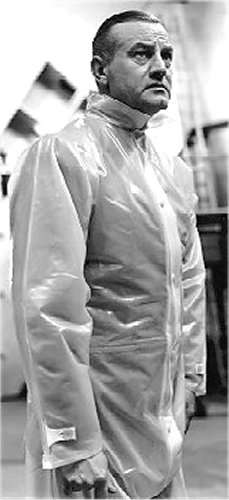 Real Name: Professor Bernard Quatermass
Real Name: Professor Bernard Quatermass
Professor Quatermass
 Real Name: Professor Bernard Quatermass
Real Name: Professor Bernard Quatermass
Identity/Class: Normal human
Occupation: Director General of the British Experimental Rocket Group, scientist
Affiliations: British Experimental Rocket Group, Dr. Gordon Briscoe, Inspector Lomax, Joe Kapp
Enemies: Victor Carroon, the Badders gangs, Martians
Known Relatives: Paula Quatermass (daughter), John Dillon (son-in-law), Hettie (granddaughter)
Aliases: None
Base of Operations: U.K.
First Appearance: The Quatermass Experiment (BBC1, 18th July 1953)
Powers/Abilities: Extremely intelligent and conversant in several scientific fields.
History: Born in the first year of the twentieth century, Bernard Quatermass was destined to grow into one of the greatest scientists of his time. Excelling in the sciences, by the 1950s he was the head of the British Experimental Rocket Group.
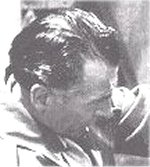 (The Quatermass Experiment) Sometime around 1953 the
BERG launched the first manned space flight from Australia, sending a three
man crew into orbit. Disaster struck when an equipment malfunction sent the
rocket thousands of miles off course and out of contact; when the vessel
returned it crashed down in Wimbledon, in the south of London, England.
Quatermass and his team had predicted the landing area, and rushed to the
crash site, but were shocked to find only one survivor, Victor Carroon, with
the other two astronauts not dead, but missing! Carroon was barely able to
talk, and cast no light on what had happened to his crewmates, but an examination
of the rocket suggested that something had boarded it and attacked the crew
on their way back to Earth. While Quatermass and Inspector Lomax of Scotland
Yard pondered this mystery, Carroon underwent a transformation, into a creature
which was as much plant as animal. As the metamorphosis continued, Carroon
became a fugitive, murdering humans and animals to feed his new form. Theorising
that this was an alien attempt to invade, Quatermass and his ally Lomax finally
caught up with the now gigantic and monstrous creature hiding in Westminster
Abbey. Quatermass theorised that the being could only exist on Earth with
the connivance of the three humans it had absorbed; he successfully persuaded
them to die in order to drive out the creature.
(The Quatermass Experiment) Sometime around 1953 the
BERG launched the first manned space flight from Australia, sending a three
man crew into orbit. Disaster struck when an equipment malfunction sent the
rocket thousands of miles off course and out of contact; when the vessel
returned it crashed down in Wimbledon, in the south of London, England.
Quatermass and his team had predicted the landing area, and rushed to the
crash site, but were shocked to find only one survivor, Victor Carroon, with
the other two astronauts not dead, but missing! Carroon was barely able to
talk, and cast no light on what had happened to his crewmates, but an examination
of the rocket suggested that something had boarded it and attacked the crew
on their way back to Earth. While Quatermass and Inspector Lomax of Scotland
Yard pondered this mystery, Carroon underwent a transformation, into a creature
which was as much plant as animal. As the metamorphosis continued, Carroon
became a fugitive, murdering humans and animals to feed his new form. Theorising
that this was an alien attempt to invade, Quatermass and his ally Lomax finally
caught up with the now gigantic and monstrous creature hiding in Westminster
Abbey. Quatermass theorised that the being could only exist on Earth with
the connivance of the three humans it had absorbed; he successfully persuaded
them to die in order to drive out the creature.
(Quatermass II) A few years later Quatermass was again working on his rockets when his daughter's fiancee, Captain John Dillon, drew his attention to the landing of a series of hollow meteorites. The scientist and his ally discovered it contained an unknown and noxious gas, and that the government seemed to be gathering the alien rocks for some sinister purpose. It soon developed that the gas was alien life form, usurping the bodies of those exposed to it, and turning them into zombie-like slaves. With the authorities under enemy control, Quatermass and his team managed to launch a nuclear rocket against the aliens' base on an asteroid, bringing to an end their evil plans.
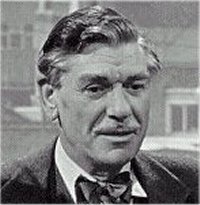 (Quatermass
and the Pit) Circa 1958, the discovery of an ancient skull under
Knightsbridge in London during construction work triggered an archaeological
dig. Further digging turned up more skulls, and then a bizarre shell made
of what appeared to be ceramic material. At first the Ministry of Defence
assumed the tube-shaped object to be an unexploded bomb, calling in both
missile experts and scientists, including Quatermass. However, when they
opened the find, it proved to contain a long dead insectoid creature unknown
to science. Quatermass suspected the thing to be a Martian which had come
to Earth more than five million years earlier, theorising that the aliens
had visited our planet to modify the brains' of man's ancestors for some
sinister purpose. His beliefs proved to be all-too correct; alien energy
contained within the remains of the creature triggered race memories hidden
in parts of the human brain, sending those exposed into violent and
uncontrollable rages, the spread of which threatened the very fabric of human
society.
(Quatermass
and the Pit) Circa 1958, the discovery of an ancient skull under
Knightsbridge in London during construction work triggered an archaeological
dig. Further digging turned up more skulls, and then a bizarre shell made
of what appeared to be ceramic material. At first the Ministry of Defence
assumed the tube-shaped object to be an unexploded bomb, calling in both
missile experts and scientists, including Quatermass. However, when they
opened the find, it proved to contain a long dead insectoid creature unknown
to science. Quatermass suspected the thing to be a Martian which had come
to Earth more than five million years earlier, theorising that the aliens
had visited our planet to modify the brains' of man's ancestors for some
sinister purpose. His beliefs proved to be all-too correct; alien energy
contained within the remains of the creature triggered race memories hidden
in parts of the human brain, sending those exposed into violent and
uncontrollable rages, the spread of which threatened the very fabric of human
society.
(Dr Who: Remembrance of the Daleks, [bts]) In 1963, two of Quatermass' BERG members were seconded to help the Army deal with what appeared to be an alien incursion into Shoreditch in London. As things became increasingly dangerous and mysterious, and a mysterious man calling himself "the Doctor" appeared to lend a hand repelling the invaders, the BERG members wondered to one another what Bernard would do in such a situation.
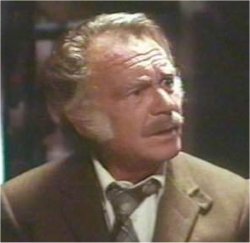 (The Quatermass Memoirs) Quatermass eventually retired,
wishing only peace and quiet. This was interrupted by a would-be biographer
who tracked him down to quiz him for his memoirs.
(The Quatermass Memoirs) Quatermass eventually retired,
wishing only peace and quiet. This was interrupted by a would-be biographer
who tracked him down to quiz him for his memoirs.
(Quatermass IV [a.k.a. The Quatermass Conclusion]) With society breaking down a few years into the future, Professor Quatermass was forced to venture out in search of his runaway granddaughter.He allied himself with Joe Kapp, who had detected signals coming from space and was trying to analyse them. The two soon came to realise the signals were from aliens, directing people to group together in pre-determined locations, where they were taken away by glowing lights. Quatermass determined that the aliens were harvesting mankind as a source of food, and with Joe he worked to stop this. He succeeded, but the strain told on the elderly scientist, who suffered a fatal heart attack.
Comments: Created by Nigel Kneale. Played by (in order) Reginald Tate, John Robinson, Brian Donlevy, André Morell, Andrew Keir, John Mills and Jason Flemyng.
The Quatermass Experiment, which introduced the character, was a first for British television on a number of fronts. Effectively treated by the production as a play dramatised over several weeks, it aired live. It was the first BBC Drama to be recorded onto film, but because the results were deemed not to a sufficient standard, only the first two episodes were recorded, meaning there is no visual record of the latter half of the story. It was also the first attempt by the BBC to do a science-fiction serial; in this area at least, it was deemed a great success. In spite of the restrictions of the special effects of the era, it was fondly remembered as one of the most atmospheric science fiction dramas of all time. Two years after it aired on BBC, Hammer Horror obtained the rights to make a movie version, the studio's first horror/science-fiction movie. The part of Quatermass, played by Reginald Tate in the original version, was played by Brian Donlevy on the big screen. Though the movie was a great success, it was considered inferior to the TV original by those lucky enough to have seen both. One noticeable difference was that the alien is defeated by being electrocuted in this version.
Meanwhile, the same year the movie came out the BBC were trying to repeat the success of the first serial with a sequel, Quatermass II. Tate was hired to play the part again, but died shortly before production commenced. André Morell was asked to take the part, but other commitments prevented this, so instead John Robinson took over as the scientist. Another success, it too was turned into a Hammer movie (in 1957), with the cinema Quatermass, Brian Donlevy, reprising his role. Again, it was considered a good movie, but not the equal of the TV version - this time at least, both versions still exist for those who wish to compare.
A year later, in 1958, the third television installment was broadcast. This time André Morell was available, and took on the part of Quatermass for Quatermass and the Pit. There was a larger gap between the TV and movie versions this time round; nine years later, in 1967, Hammer released their adaption, this time starring Andrew Keir.
It was twenty years between Nigel Keane writing Quatermass and the Pit and his next Quatermass story. Finally, in 1978, he brought the character back for the Thames Television mini-series Quatermass IV starring John Mills as Quatermass in a slightly dystopian near-future setting. This mini-series was then edited down to a 105 minute movie, dubbed The Quatermass Conclusion, for the American market.
Novels for all the stories were written by Quatermass' creator, Nigel Kneale.
In 1977 House of Hammer magazine #8-9 carried a comic strip adaptation of The Quatermass Xperiment, and the following year, the retitled Hammer's Halls of Horror #23 published Steve Parkhouse and David Lloyd's adaptation of the second Hammer movie.
|
|
In 1996 Kneale returned to the character in a five part radio serial for BBC Radio Three. Andrew Keir, the last cinematic Quatermass, reprised the roll for The Quatermass Memoirs, set after the first three stories, and (since the character was still alive) before the fourth. The first episode aired on 4th March, 1996, with the subsequent four episodes following on one day later apiece.
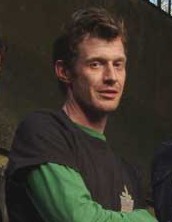 In
2005 a new Quatermass Experiment was filmed live, with Jason Flemyng
playing the part of Professor Bernard Quatermass.
In
2005 a new Quatermass Experiment was filmed live, with Jason Flemyng
playing the part of Professor Bernard Quatermass.
Quatermass heavily influenced Doctor Who, and in turn the show has hinted a few times that the character exists within the Doctor's universe. The British Rocket Group and "Bernard" are both namechecked in the 1988 serial Remembrance of the Daleks, and the BRG's logo was used in the 2005 story The Christmas Invasion, while 2009's Planet of the Dead has UNIT scientific advisor Malcolm Taylor admit he named a new unit of measurement the "Bernard" in honour of BRG's Bernard Quatermass. The 1997 Doctor Who novel The Dying Days gives Quatermass his only actual appearance in the Doctor Who universe, in a short appearance where his full name is never completely spoken, and the 2008 novel Beautiful Chaos confirms the tenth Doctor to be friends with Quatermass and his daughter.
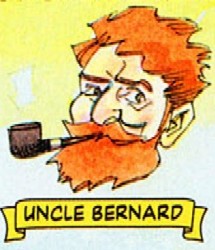 Quatermass
makes a cameo appearance in League of Extraordinary
Gentlemen: Black Dossier, and the subsequent League of Extraordinary
Gentlemen: Century 1910 hints he may have been transformed into a being dubbed
"the 'Mass" who battled the Seven Stars.
Quatermass
makes a cameo appearance in League of Extraordinary
Gentlemen: Black Dossier, and the subsequent League of Extraordinary
Gentlemen: Century 1910 hints he may have been transformed into a being dubbed
"the 'Mass" who battled the Seven Stars.
CLARIFICATIONS: Not to be confused with
Allan Quatermain, great white hunter
any other Professors
Any Additions/Corrections? Please let me know.
All images and characters depicted are copyright their respective holders, and are used above for informational purposes only. No infringement is intended and copyrights remain at source.